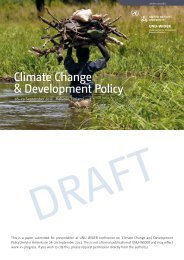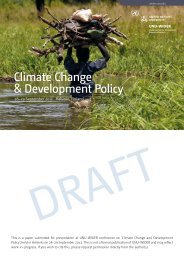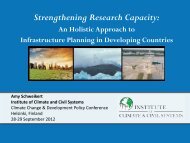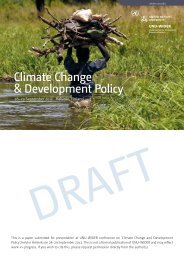Landscape architecture role in mitigating negative ... - UNU-WIDER
Landscape architecture role in mitigating negative ... - UNU-WIDER
Landscape architecture role in mitigating negative ... - UNU-WIDER
You also want an ePaper? Increase the reach of your titles
YUMPU automatically turns print PDFs into web optimized ePapers that Google loves.
size, characteristics and shape. The ‘different sizes and shapes of cities imply different<br />
geographical advantages’ (Batty 2008). It should be noted that density is one key issue. The<br />
relation between Urban Density and Greenhouse Gas Emissions depends on the follow<strong>in</strong>g<br />
factors:<br />
i. The relative contribution of cities<br />
ii. Patterns of mobility<br />
iii. Hous<strong>in</strong>g densities and energy consumption. 5<br />
3.4. Climate change and urbanization <strong>in</strong> MENA cities:<br />
In MINA areas, most of the cities are characterized by high density and crowded. Attention from<br />
MENA cities towards Climate Change and its l<strong>in</strong>kages between urbanization and climate change<br />
are positively developed. Illustrate the significant contribution of <strong>Landscape</strong> Architecture with<strong>in</strong><br />
urban areas due to climate change is one of the important item <strong>in</strong> shar<strong>in</strong>g the public participation<br />
to the problem, while at the same time highlight<strong>in</strong>g the potentially devastat<strong>in</strong>g effects of climate<br />
change on urban populations' environment. It reviews policy responses, strategies and practices<br />
that are emerg<strong>in</strong>g <strong>in</strong> urban areas to mitigate and adapt to climate change, as well as their<br />
potential achievements and constra<strong>in</strong>ts.<br />
Figure 1. Alexandria, costal city suffer from climatic changes impacts.<br />
In urbanization process, the primary task of municipal leaders is to care for their own citizens, as<br />
entity concern. Climate change is affect<strong>in</strong>g municipal policy because it is public <strong>in</strong>stitutions who<br />
decide on “land‐use plann<strong>in</strong>g, adopt<strong>in</strong>g construction codes, Build<strong>in</strong>g design and are responsible<br />
for the <strong>in</strong>vestments <strong>in</strong> general and prevention measures. Therefore, decision makers will need to<br />
become as <strong>in</strong>formed as possible about climate change impacts.<br />
However, successful responses to the challenges of climate change will require change <strong>in</strong> how<br />
urban areas operate. Such response also requests enhancement of coord<strong>in</strong>ation between local<br />
governments, civil society, community and private sector stakeholders, while at the same time<br />
build<strong>in</strong>g new connection between central power structures and marg<strong>in</strong>alized segments of urban<br />
populations.<br />
Table 1, shows the major Climate Change Impacts <strong>in</strong> Urban Areas: (Changes <strong>in</strong> Means)<br />
Change Urban impacts Health impacts<br />
i. Temperature Increased energy demand for<br />
heat<strong>in</strong>g / cool<strong>in</strong>g; worsen<strong>in</strong>g of<br />
air quality<br />
Increased vulnerability to /respiratory;<br />
diseases young؛ and elderly particularly at<br />
risk<br />
ii. Precipitation Increased risk of flood<strong>in</strong>g;<br />
<strong>in</strong>creased risk of landslides;<br />
distress migration<br />
iii. Sea‐level rise Coastal flood<strong>in</strong>g; Stal<strong>in</strong>ization<br />
of water sources<br />
Increase water‐borne and water‐washed<br />
diseases; food shortages and malnutrition<br />
Loss of land and property; health problems<br />
from sal<strong>in</strong>ated water (especially children)








